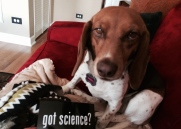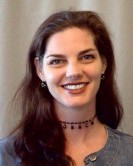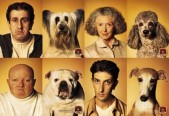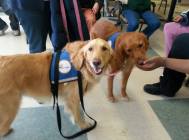 They love us, they help us, they often entertain us – any way you look at it, dogs are an important part of human life. Whether they are bringing us joy as members of the family, using their keen sense of smell in forensic efforts, or helping people with disabilities navigate their lives with more ease, dogs enrich our lives daily (just check out the face on Science is Sexy’s resident pooch, Bagels the beagle, if you need to be convinced). Dogs and humans have been companions for an estimated 30,000 years, but science is only beginning to reveal why dogs bond with us so deeply, and why we bond with our dogs. Science is Sexy is pleased to partner with our friends at the Brain Research Foundation, Canine Therapy Corps and the Anti-Cruelty Society to bring you a fascinating spring program about the neuroscience of the bond between humans and dogs.
They love us, they help us, they often entertain us – any way you look at it, dogs are an important part of human life. Whether they are bringing us joy as members of the family, using their keen sense of smell in forensic efforts, or helping people with disabilities navigate their lives with more ease, dogs enrich our lives daily (just check out the face on Science is Sexy’s resident pooch, Bagels the beagle, if you need to be convinced). Dogs and humans have been companions for an estimated 30,000 years, but science is only beginning to reveal why dogs bond with us so deeply, and why we bond with our dogs. Science is Sexy is pleased to partner with our friends at the Brain Research Foundation, Canine Therapy Corps and the Anti-Cruelty Society to bring you a fascinating spring program about the neuroscience of the bond between humans and dogs.
 There is growing evidence that the human-animal bond positively influences human emotional and behavioral healt
There is growing evidence that the human-animal bond positively influences human emotional and behavioral healt h, but not much is known about the biological mechanisms that underlie those benefits. At the University of Chicago, Kristen Jacobson, Ph.D. is at the forefront of this research to understand why dogs have such positive impacts on our health and happiness. Dr. Jacobsen studies human-animal interaction (HAI), which is helping us better understand science behind the human bond to dogs and how it supports our
h, but not much is known about the biological mechanisms that underlie those benefits. At the University of Chicago, Kristen Jacobson, Ph.D. is at the forefront of this research to understand why dogs have such positive impacts on our health and happiness. Dr. Jacobsen studies human-animal interaction (HAI), which is helping us better understand science behind the human bond to dogs and how it supports our  neurobiological and psychological well-being. Through behavioral, genetic, and neurobiological studies, including functional MRI, Dr. Jacobsen is learning about how down time with man’s best friend affects our stress hormones, what parts of the brain cause us to bond to our pooches, and even why people and their dogs behave similarly over time.
neurobiological and psychological well-being. Through behavioral, genetic, and neurobiological studies, including functional MRI, Dr. Jacobsen is learning about how down time with man’s best friend affects our stress hormones, what parts of the brain cause us to bond to our pooches, and even why people and their dogs behave similarly over time.
 Not only will you have the opportunity to spend an evening with one of Chicago’s leading scientists, you’ll also be able to enjoy the company of several therapy dogs in attendance from Canine Therapy Corps. These gentle, brilliant dogs motivate individuals recovering from physical and emotional trauma to overcome difficult circumstances including disabilities, injuries, or other challenges, by providing goal-directed, interactive therapy as part of the treatment or rehabilitation process. There’s just no way that you won’t head home happier and more relaxed after petting their sweet faces!
Not only will you have the opportunity to spend an evening with one of Chicago’s leading scientists, you’ll also be able to enjoy the company of several therapy dogs in attendance from Canine Therapy Corps. These gentle, brilliant dogs motivate individuals recovering from physical and emotional trauma to overcome difficult circumstances including disabilities, injuries, or other challenges, by providing goal-directed, interactive therapy as part of the treatment or rehabilitation process. There’s just no way that you won’t head home happier and more relaxed after petting their sweet faces!
The event is free, but we’ll be accepting donations to support the great work of Canine Therapy Corps and the Anti-Cruelty Society. Don’t miss this special opportunity to see what happens when science goes to the dogs!
DATE: May 29, 2014
TIME: 6:30-7:30 PM – talk and Q&A
7:30-8:00 PM (chat with the scientist and get to know the dogs)
LOCATION: Anti-Cruelty Society (169 W. Grand Ave.)
Free Parking on Wells St.
Brown Line to Merchandise Mart or Red Line to Grand
21+, no Pre-Registration Required
 Science is Sexy is proud to partner with The Brain Research Foundation and the Canine Therapy Corps. The Brain Research Foundation supports neuroscience research that leads to advanced understanding of brain function in children and adults. The Foundation is committed to advancing discoveries that will lead to novel treatments and prevention of all neurological diseases. The BRF delivers this commitment through both research grant programs, which provide initial funding for innovative research projects, as well as educational programs for researchers and the general public. Visit the Brain Research Foundation on Twitter, Facebook and YouTube.
Science is Sexy is proud to partner with The Brain Research Foundation and the Canine Therapy Corps. The Brain Research Foundation supports neuroscience research that leads to advanced understanding of brain function in children and adults. The Foundation is committed to advancing discoveries that will lead to novel treatments and prevention of all neurological diseases. The BRF delivers this commitment through both research grant programs, which provide initial funding for innovative research projects, as well as educational programs for researchers and the general public. Visit the Brain Research Foundation on Twitter, Facebook and YouTube.
 The Canine Therapy Corps empowers and motivates individuals to improve their physical and psychological health and well-being by harnessing the human-animal bond. Additionally, they provide goal-directed, interactive, animal-assisted therapy services, free of charge, using volunteers and certified therapy dogs, while working to advance animal assisted interventions through research and collaboration. To learn more about the work of the Canine Therapy Corps, please visit them on Twitter and Facebook.
The Canine Therapy Corps empowers and motivates individuals to improve their physical and psychological health and well-being by harnessing the human-animal bond. Additionally, they provide goal-directed, interactive, animal-assisted therapy services, free of charge, using volunteers and certified therapy dogs, while working to advance animal assisted interventions through research and collaboration. To learn more about the work of the Canine Therapy Corps, please visit them on Twitter and Facebook.
About Science is Sexy and Night Lab
Molecular Geneticist and Cell Biologist Stephanie Levi, Ph.D. has a passion for making science enjoyable and accessible for the general public, and created Night Lab to bring educational and entertaining science programming to adults in Chicago in November 2008. Night Lab is designed to give non-scientists a short and sweet taste of science in their everyday lives, highlighting the people and organizations that make Chicago a rockstar city for science. While offering adults in the city innovative opportunities to engage in the excitement and beauty of science, our programs give members of Chicago’s science community a fantastic way to connect to the rest of the city outside of the lab. Our programs are perfect for people who flunked chemistry, think genes come from The Gap, or think “that’s hard!” when they hear the word molecular. Whether you are just curious about science or a professional scientist, Night Lab is for you.
Visit the Science is Sexy website for a blog, our press, information about workshops, career development opportunities for scientists, and more science fun!

 Last month, an
Last month, an  is a member of Argonne’s
is a member of Argonne’s  remote parts of the world, and what his research is telling us about the birth and evolution of our universe. Don’t miss this opportunity to hang out and talk science with one of Chicago’s leading cosmic physicists for an evening.
remote parts of the world, and what his research is telling us about the birth and evolution of our universe. Don’t miss this opportunity to hang out and talk science with one of Chicago’s leading cosmic physicists for an evening. Okay, so maybe we’re not exactly experts at writing fairy tales (we’re much better at non-fiction – really), but there’s some truth to our (ridiculous) attempt – recent years have seen science hopping out of silos and mingling with other fields in a bevy of interdisciplinary adventures, as it should, since science really does intersect everything. In March, we’re incredibly proud to partner with our good friends at the Guild Literary Complex, which has been working for over 25 years to showcase Chicago’s incredible literary talent, for a shared installment of their monthly series, “Applied Words,” which I am thrilled to be guest curating this month. Applied Words features a series of incredible local writers reading on a theme, and this month’s theme is “Unseen Worlds,” inspired by the secret worlds scientists encounter in our work.
Okay, so maybe we’re not exactly experts at writing fairy tales (we’re much better at non-fiction – really), but there’s some truth to our (ridiculous) attempt – recent years have seen science hopping out of silos and mingling with other fields in a bevy of interdisciplinary adventures, as it should, since science really does intersect everything. In March, we’re incredibly proud to partner with our good friends at the Guild Literary Complex, which has been working for over 25 years to showcase Chicago’s incredible literary talent, for a shared installment of their monthly series, “Applied Words,” which I am thrilled to be guest curating this month. Applied Words features a series of incredible local writers reading on a theme, and this month’s theme is “Unseen Worlds,” inspired by the secret worlds scientists encounter in our work. The event pulls together an all-star cast of scientists and writers (some do both), highlighting the incredible cross-disciplinary talents that Chicago boasts. “Unseen Worlds” stemmed from the experiences that we scientists often have while doing exciting research that relies on the incredible microscopes at area institutions (but few in the public get the chance to experience – although we’re out to change that!). It’s easy to be captivated by the images that microscopes capture, and the idea that there are worlds that are visible far beyond what our naked eye is capable of visualizing is exciting to scientists and non-scientists alike (just check out the images interspersed in this newsletter!).
The event pulls together an all-star cast of scientists and writers (some do both), highlighting the incredible cross-disciplinary talents that Chicago boasts. “Unseen Worlds” stemmed from the experiences that we scientists often have while doing exciting research that relies on the incredible microscopes at area institutions (but few in the public get the chance to experience – although we’re out to change that!). It’s easy to be captivated by the images that microscopes capture, and the idea that there are worlds that are visible far beyond what our naked eye is capable of visualizing is exciting to scientists and non-scientists alike (just check out the images interspersed in this newsletter!). Beyond that inspiration, there are communities of people who can’t necessarily access science easily or are underrepresented in STEM, and we see the theme as an opportunity to highlight these communities and populations, understand the connection between science and social justice, and support their engagement and interest in science and math. The theme also crosses disciplines, exploring how science and the arts and humanities intersect, and what happens when they do.
Beyond that inspiration, there are communities of people who can’t necessarily access science easily or are underrepresented in STEM, and we see the theme as an opportunity to highlight these communities and populations, understand the connection between science and social justice, and support their engagement and interest in science and math. The theme also crosses disciplines, exploring how science and the arts and humanities intersect, and what happens when they do. Jotham (Joe) Austin, II received his BS in Biology from Penn State University-Behrend, but when not in the lab he was busy writing short stories and poems. He attended graduate school at Arizona State University, where he received his PhD in Botany. One could say his love of writing continued to blossom: Joe started reading his poems at coffeehouses and small venues around Tempe, AZ, and eventually formed a poetry/music combo with Robbie Roberson, director of Electron Microscopy. After taking a Postdoctoral position in Microscopy in Boulder, CO, he made his way to Chicago where he currently is Director of the University of Chicago’s Electron Microscopy Core Facility. Joe returned to creative writing after tearing his Achilles tendon, finishing his first novel, Pretty Small Things. He now knows the true meaning of rejection as he chases publication, but everyone loves his homebrew.
Jotham (Joe) Austin, II received his BS in Biology from Penn State University-Behrend, but when not in the lab he was busy writing short stories and poems. He attended graduate school at Arizona State University, where he received his PhD in Botany. One could say his love of writing continued to blossom: Joe started reading his poems at coffeehouses and small venues around Tempe, AZ, and eventually formed a poetry/music combo with Robbie Roberson, director of Electron Microscopy. After taking a Postdoctoral position in Microscopy in Boulder, CO, he made his way to Chicago where he currently is Director of the University of Chicago’s Electron Microscopy Core Facility. Joe returned to creative writing after tearing his Achilles tendon, finishing his first novel, Pretty Small Things. He now knows the true meaning of rejection as he chases publication, but everyone loves his homebrew. Paul Gorski majored in biology and chemistry before taking a job as a technical copywriter. After coordinating his marketing department’s move to digital publishing in the early ‘90s, he moved on to develop and support digital publishing systems used by ad agencies, newspapers and publishers. Paul currently supports publishing workflows at the American Dental Association in Chicago. He also writes two weekly columns for The Rock River Times newspaper in Rockford, where he lives with his wife and children. Somewhere between Chicago and Rockford he pauses long enough to manage
Paul Gorski majored in biology and chemistry before taking a job as a technical copywriter. After coordinating his marketing department’s move to digital publishing in the early ‘90s, he moved on to develop and support digital publishing systems used by ad agencies, newspapers and publishers. Paul currently supports publishing workflows at the American Dental Association in Chicago. He also writes two weekly columns for The Rock River Times newspaper in Rockford, where he lives with his wife and children. Somewhere between Chicago and Rockford he pauses long enough to manage  Vojislav Pejović (“voice-love peyovich”) is a neurobiologist by training and earns his living as a medical writer. In 2008, he published a critically acclaimed novel in his native Montenegro, and in 2010, translations of Charles Simic’s poetry in Serbo-Croatian. He also wrote a couple of movie scripts. His current project is a collection of stories in English and Serbo-Croatian. He lives in Evanston with his wife and their two sons.
Vojislav Pejović (“voice-love peyovich”) is a neurobiologist by training and earns his living as a medical writer. In 2008, he published a critically acclaimed novel in his native Montenegro, and in 2010, translations of Charles Simic’s poetry in Serbo-Croatian. He also wrote a couple of movie scripts. His current project is a collection of stories in English and Serbo-Croatian. He lives in Evanston with his wife and their two sons. Anne K. Yoder is a staff writer for the online literary magazine The Millions and is the co-editrix of Projecttile, a journal of nontraditional writing with a feminist bent. When she’s not dealing in words, she’s dealing in pharmaceuticals, legally. She’s a registered pharmacist in three states and she’s moonlighted as a hospital pharmacist for over ten years to support her writing habit. Her fiction, nonfiction, and criticism have appeared in Fence, Bomb, and Tin House, among other publications.
Anne K. Yoder is a staff writer for the online literary magazine The Millions and is the co-editrix of Projecttile, a journal of nontraditional writing with a feminist bent. When she’s not dealing in words, she’s dealing in pharmaceuticals, legally. She’s a registered pharmacist in three states and she’s moonlighted as a hospital pharmacist for over ten years to support her writing habit. Her fiction, nonfiction, and criticism have appeared in Fence, Bomb, and Tin House, among other publications.
 Who do you love? Northwestern University’s
Who do you love? Northwestern University’s  arousal and response in people of various sexual orientations. Join us for a thought-provoking evening of scientific discovery with one of Chicago’s leading researchers.
arousal and response in people of various sexual orientations. Join us for a thought-provoking evening of scientific discovery with one of Chicago’s leading researchers. Science is Sexy is proud to partner with
Science is Sexy is proud to partner with 








You must be logged in to post a comment.